When it comes to Neapolitan, ready-to-wear suits and jackets Isaia – along with Kiton and Attolini – is one of the most well-known brands that represents that sector. Their products are priced quite steeply, so today, we discover whether they’re worth your hard-earned money or not.
Isaia suits and jackets have very nice fabrics often in bold colors that just ooze Italian or Mediterranean charm and flair. However, they also cost a whole lot of money ranging from $4,000 all the way up to $15,000. Dang, I can get a cruise for less than that around the Italian Peninsula!
So, whether a brand charges that much for a garment, the question arises: is it really worth all that money? As you know, we always take a closer look at these things in our reviews.
![Sport Jacket The Domenico Sport Jacket product listing on Isaia's website with a price of $3,995. [Image Credit: Isaia]](https://www.gentlemansgazette.com/wp-content/uploads/2022/05/sport-jacket-1030x582.jpg)
As full disclosure, though, this review is 100% not sponsored – all the garments you see here were purchased by me with our own money. So, we’re not biased in any way.
Facimme ‘na cosa ‘e journe – which means as much as “let’s get going” or “let’s get this done today.”
History of Isaia
Isaia started as a cloth merchant in 1920 in Naples, Italy. The founder Enrico Isaia didn’t just sell fabric, but he was also a tailor and according to their website he was also working with Attolini. Not just any Attolini, but Cesare Attolini.
Cesare was the son of Vincenzo Attolini, who’s often credited for developing the Neapolitan suit style. It was basically a British suit, but it made it softer with different fabrics and less padding. Also, there’s quite a bit more visible handwork. In addition to being a fabric wholesaler, they also had a little tailoring atelier.
![Brothers The Isaia brothers [Image Credit: Isaia]](https://www.gentlemansgazette.com/wp-content/uploads/2022/05/brothers-1030x575.jpg)
In 1957, Enrico – together with his brothers Rosario and Corrado – moved operations to the small town of Casalnuovo. This small town is known for its clothes trades and, of the 14,000 inhabitants, about half of them are directly related in the clothes industry.
One could argue that 1957 was the true inception of the Isaia brand as it’s known today because that’s when it started making suits. For several decades, Isaia would produce private-label goods for other brands – most famously, Valentino.
It wasn’t till the 1980s that Isaia used their brand recognition and leveraged that to expand to markets in Asia, Europe, in North America, so consumers would actually know Isaia as a brand and not just the Valentino garment, for example.
![Old Store The old Isaia store in Casalnuovo [Image Credit: Isaia]](https://www.gentlemansgazette.com/wp-content/uploads/2022/05/old-store-1030x578.jpg)
In the 90s and 2000s, Isaia grew rapidly, particularly in the ready-to-wear sector, but they still capped on the traditional bespoke and made-to-measure items. By the way, if you’re not sure what these terms mean, we got a guide for you.
Along with the expansion, they developed a whole line of accessories, shoes, and other clothing items, but the entire growth was certainly fueled by advertising campaigns. They let storytelling, drama, and titillation really get their name out there with consumers.
Nowadays, brands like SuitSupply have done the same but, back in the day, Isaia was certainly early on. And marketing has changed anyhow because of social media, Instagram, YouTube, and so forth.
![Ad Two Isaia ads from different campaigns: "Suit up differently" (left) and MiniMe" (right), both by the ad agency, Paola Manfrin [Image Credit: Ads of the World]](https://www.gentlemansgazette.com/wp-content/uploads/2022/05/ad-1030x578.jpg)
Isaia also trades heavily on their family heritage and today the CEO Gianluca Isaia is a descendant of the founder and many other family members are employed in the company.
Initially, their logo was rather unexciting but, eventually, they switched it and Isaia is now well known for the coral red, and coral is particularly associated with Naples. To even go a step further, every new Isaia jacket has that little coral clip and sometimes you see coral patterns underneath the collar, for example, or on the inside of the lining.

They really adapted this classic Neapolitan symbol for their brand. It definitely stands out and, because their suits are expensive, people use them as a status symbol to signal “I can afford an expensive jacket or suit.” You can even buy those individual lapel pins – sometimes second-hand on eBay.
According to legend, this red coral was created by the blood of Medusa. As the story goes, seaweed was turned into this red coral. Today, the red coral in Naples is known as a sign of victory and good fortune and it’s used in jewelry, cameos, and other accessories.
What Makes Isaia Special?
Isaia garments heavily lean on their Neapolitan heritage, but what exactly does that mean?
Suit/Jacket Configuration
Typically, you find a very trim silhouette paired with a high gorge. The shoulders are unpadded and soft – similarly to a shirt. Typically, the sleeve head also has a bit of roping and you’ll find those little wrinkles, also known as grinze. It’s a very Neapolitan detail that you wouldn’t find in a traditional German or English suit for example. The palettes are not overly wide, but also not super slim. The quarters on single-breasted jackets are cut relatively open.

If you look at older Isaia jackets, even sport coats, they were often typically rather what I call more boring; they were single-breasted, two-button, or three-row-two jackets with flat pockets and side vents.
Because of people like Lino from Al Bazar Milano, that whole double-breasted style with patch pockets has become much more popular, and more recent Isaia sport coats all feature patch pockets, at least at the bottom, sometimes also with a chest pocket. It just underlines the more casual, vibrant, Italian character. Of course, they also carry navy or gray suits, but they have bold stuff like a white jacket with a black windowpane or a bold blue suit, for example.
![Lino Lino Ieluzzi, owner of Al Bazar Milano, in a powder blue double-breasted sport coat with patch pockets [Image Credit: Watch Collecting Lifestyle]](https://www.gentlemansgazette.com/wp-content/uploads/2022/05/Lino-1030x577.jpg)
For the typical non-Italian, an Isaia garment exudes an element of sprezzatura.
What Exactly is Sprezzatura?
Products & Prices
So, where can you buy Isaia goods? Well, of course, directly from them on their website, but they really got big by selling through department stores and haberdasheries. They’re intentionally priced on the higher end, so the middlemen can make a healthy profit.
For example, a pair of swim trunks is $300, or a pair of crocodile leather hiking boots, $12,000. I don’t think I’d go hiking in 12-grand boots. But, hey, each to his own.
![Hiking Boot Isaia's crocodile leather hiking boots are priced at $12,500 [Image Credit: Isaia]](https://www.gentlemansgazette.com/wp-content/uploads/2022/05/hiking-boot-1030x580.jpg)
The shirts range from an already high $300 to an incredibly high $12,000. Comparatively, there are ready-to-wear pants, which are cut rather slim, and are priced between $630 and $1,000. I mean, a steal, right?
Ready-to-wear jackets typically range between $3,900 and $5,600 roughly. Suits start at about $4,600 and they can go up all the way to $15,000 depending on the fabric you choose. That price, you only reach typically if you go with their made-to-measure program.
Product Sizing and Details
What about sizing? I’d say, for the American market, Isaia runs rather small and they use European sizing. So, typically, if you have a size 54 in Italy, that converts to size 44 in the US. I would say, with Isaia, if you typically wear a 42 in the US, then you go with a 54.

So, you size one up in the Italian size to get the fit that you want; unless, of course, you like a super trim fit, then translate with a more traditional 42 to 52. In my case, I typically wear 42 or 43 in Isaia. I definitely need a 54; a 52 would not work for me.
I’ve tried on some of their suits and pants and they just never worked for me. But, as you know, I have a big bum and big thighs. They sometimes offer short and long sizes, but they’re a little harder to find.
Material
Compared to other luxury retailers, Isaia actually provides quite a bit of information about their jacket details and the fabric on their website; talks about the interior pockets, the melton, the double-button tab closure, the welted barchetta, little boat-like pocket, the yarn-dyed Bemberg lining, the horsehair canvas, and so forth.
![Details Isaia shares more information on their product listings compared to other luxury retailers [Image Credit: Isaia]](https://www.gentlemansgazette.com/wp-content/uploads/2022/05/details-1030x581.jpg)
When it comes to material, sometimes they just talk about Mongolian cashmere and don’t go into too much detail when it comes to staple length and the ply. With their woolen garments, they seem to provide a little more information.
Overall, as you can expect at that price, the materials are all expensive and have a very soft touch. So, if you like that, you will like Isaia. If you like really thick, heavy tweeds, then Isaia is not the brand for you. But, their focus and strong suit are more expensive fabrics that feel soft and look casual and summery.
For their suiting, they have something called Aquaspider 160s, which is a fine, worsted wool that has a treatment that makes the water run off. So, if you forget your umbrella, you’ll stay dry in that suit.

Keep in mind that wool in general is a much better water repellent than, let’s say, a cotton cedar sucker suit. The Aquaspider is a 15.75 micron wool. They also have other series with 14.5 microns. Of course, at that point everything feels softer and even more luxurious.
It’s not necessarily a super hard-wearing fabric, but it feels good. Of course, Isaia highlights that it’s made in Italy. And to learn more what that really means and if it matters, check out this video here.
How Are Isaia Suits Made?
Isaia is a factory suit; it’s not a fully handmade suit where a tailor cuts everything by hand. They use modern technology and understand how to produce Neapolitan-style suits at scale.


Yes, the Isaia jacket has quite a bit of handwork – the collar is hand-sewn, the buttonholes are hand-stitched, and there’s a little handwork here and there, but overall, they still use machines to make these garments. They also hand iron their suits. And if you want to learn how you can do that at home, we have a guide for you.
How to Iron a Suit Jacket: Part IV – The Complete Guide to Ironing
Apart from the taschino a barchetta, which is the little boat, rounded shape that you typically find on Neapolitan jackets, it has a slew of other things that they do. Oftentimes, they’ve very bold, melton, under collar linings so, when you for some reason want to flip up your collar, it looks very bold and casual.
For ready-to-wear, they also have nice high armholes which, again, allows you to have a better range of movement. The pants have a v-notched waistband or split waistband, they have a nice cotton lining, and I also have about two-thirds of an inch on the sides so you can let out the pants more than, let’s say, a pair of pants from H&M.
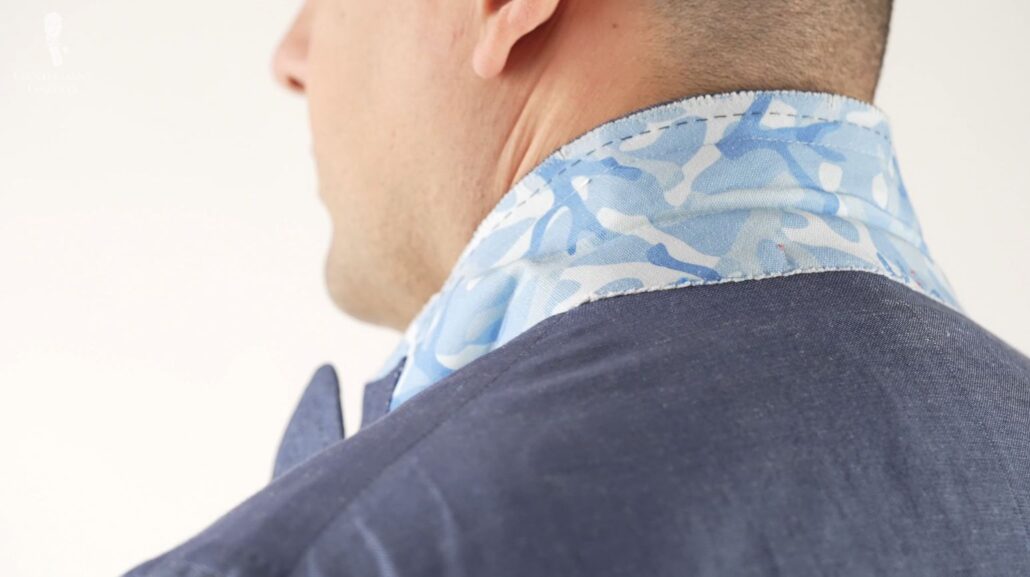
Personally, what I really like about Isaia and, in my opinion, makes it stand out from other ready-to-wear brands is the fact that it’s a very soft and comfortable jacket. I had jackets that had sleeves that were cut as slim, but I couldn’t move around in it as freely. But, that’s not something that you can see in a picture. It’s something that you have to feel when you wear the jacket.
I think they achieve it by cutting the fabric in a way that gives them stretch because, as you know, a woven fabric has one direction in which it stretches very well and the other direction in which it doesn’t stretch at all. Another thing I really like about them is the fabrics are lightweight, but they’re not too wrinkly.

Because the jackets are lightweight and summery, they’re often just quarter-lined; meaning the shoulders aligned on top as well as the sleeves, but the rest is unlined. And, typically, that takes a bit more skill in finishing and is more expensive than a jacket that is all lined. I know – counter-intuitive. But, that’s just how it works.
When it comes to their materials, I think they’re almost as good as Kiton. Kiton is a brand that, in my mind, really epitomizes this luxurious fabric that is super soft for a very fine yarn. Personally, I find Attolini typically to not have as nice fabrics. So, I would say Kiton, Isaia, and then Attolini in terms of fabric quality. Of course, that’s simplified and just one grading for my overall impression, and I’m certain you can get very similar comparable fabrics from all three brands if you go made-to-measure for example.

For ready-to-wear though, I think they do a pretty nice job of selecting something that is out of the ordinary and, even though you get a blue blazer for example, it’s not what your father or grandfather would have worn. I also believe that they’re really good with blends. So, oftentimes, you will see it’s not just a pure wool or pure linen, but it’s always blended in a way that makes it less wrinkly or provides a nicer texture or a softer touch.
Overall, the quality of workmanship is pretty high, so you see handwork in areas like buttonholes, under the collar, and there’s little tacks.
They also sometimes have monograms. If you look at the sleeve lining, you see irregular stitches but, looking at the padding of the canvas, that is done by machine. Also, the pique stitching – which is something you often find in Neapolitan garments, not just along the typical areas of the lapel edges but also along the sleeves or the darts or the entire edges – seems to be done by machine.

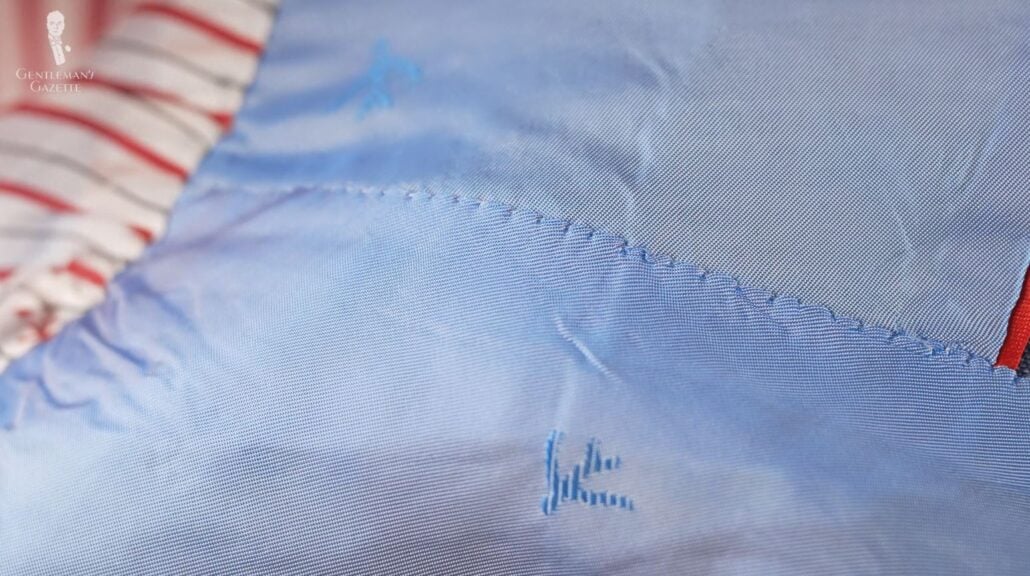
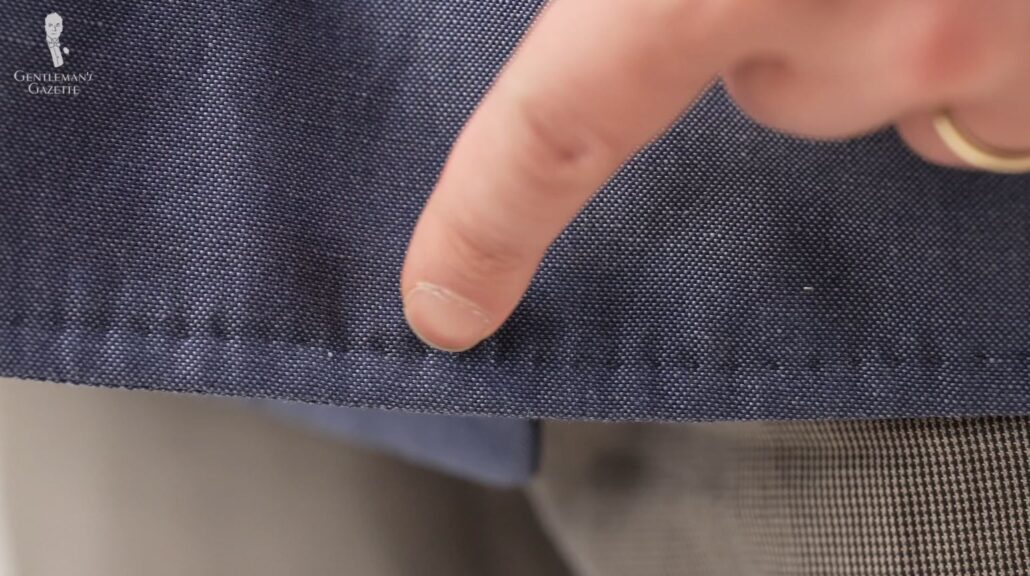
The buttons are often mother of pearl or corozo or horn and are of decent quality. Many ready-to-wear jackets come without buttonholes on the sleeves, so you can more easily adjust them, but they sometimes also come with them.
And made-to-measure, of course, have the cut buttonholes on your sleeve. When it comes to rounded corners, which is a little detail that you find in higher-end garments, I can see them, for example, at the point of the lapel or the bottom of my double-breasted jacket. However, the sleeves, for example, have pointed edges, whereas if you look at a garment from a bespoke tailor like Caraceni, they spend a lot of time making sure that every corner is rounded.
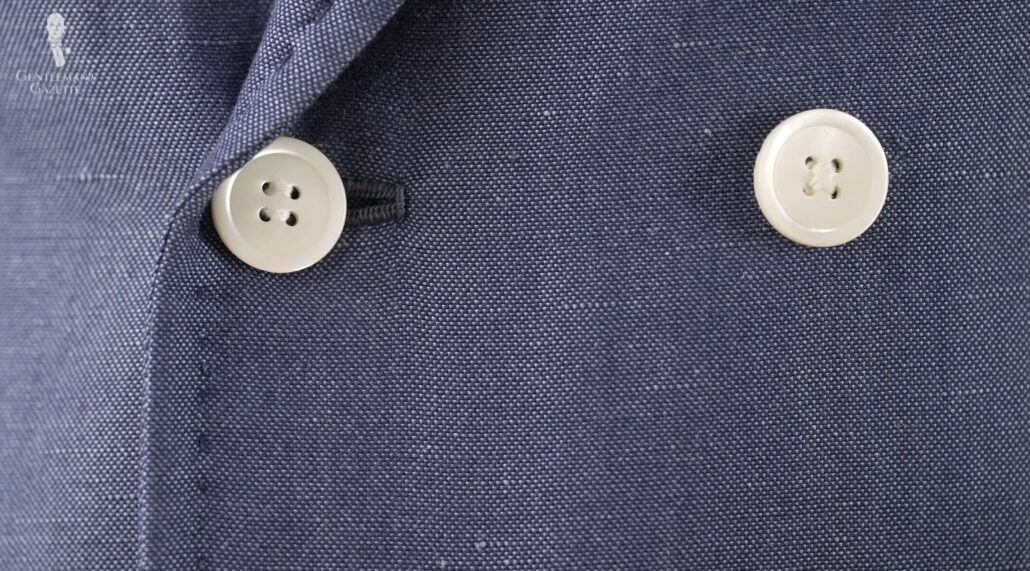
What’s the advantage of that? Well, if it’s slightly more rounded, you’ll have less wear versus, if you have a strong point, probably you’ll wear that edge and it won’t last as long and it will not look as nice.
Assessing Our Isaia Products
In terms of pattern matching, I think you do a decent job. You will have patterns matched in the back, for example, sleeve to body; with the patch pockets, it doesn’t always work that way and so they just have one thing that’s aligned but not the other. But, it’s typical with darts. Talking about darts, they have the typical Neapolitan method, where the dart reaches all the way down in the front, so you see it underneath the pocket.
As you know, the most expensive is worthless if it doesn’t fit you and we have a whole series that shows you how a suit should ideally fit. Obviously, fit is a subjective thing and, for me personally, Isaia ready-to-wear garments fit quite well.

I should say Isaia jackets fit me quite well. Pants, on the other hand, not so much. They’re just too slim and I could never find a suit that worked for me. No, their fit is not perfect off-the-rack, but what I do like about the cut is the high armholes – make it easy or easier to move around than in other jackets that are cut in a similar fashion.
Overall, it has this hourglass shape with a waist suppression. There is not much of a drape in those jackets. They fit relatively closely to your body, but they’re so soft that they’re very comfortable to wear.
Oftentimes, in jackets, when they have similarly tight sleeves as the Isaia ones, I got a lot more collar gap when I move around and a lot more restriction. I still do get restrictions in the upper arm because it’s not wide enough for my arm. But, I can move around better than in most other ready-to-wear jackets. Sometimes, they also have long sleeves, which works in my favor because I typically always have to let my sleeves out.


As you know, my right shoulder is more sloped and lower than my left one but, when I put on the symmetrical ready-to-wear jacket, I think it does a pretty good job in not highlighting that right away. Of course, a tailor with a trained eye will immediately see it but, on average, I find that it hides my flaws better than other garments do.
I think some people might challenge that this is the true Neapolitan jacket and they say, “Well, there’s not enough handwork and this little detail is off.” But, overall, I think they get the whole sentiment of the Neapolitan jacket right.
Is Isaia Worth It?
If you look at our suit grading video, you saw that I rated Isaia quite highly in terms of overall quality and, of course, the fact that it fits me well plays into that. So, I think, for a ready-to-wear garment, you get a good-quality product.
However, looking at the price, I feel like the value you get from Isaia is pretty poor. So, let’s say the quality is an A-, I think the value you get is more of a D at retail price. Just because it’s obnoxiously expensive for the money you have to spend to get an Isaia garment, you can go to an actual craftsman, get a fully custom bespoke suit with the details you want, with a perfect fit, in the exact fabric you want, with all the bells and whistles, and all customizations, and you pay less than what you pay for this garment.
![Grey Suit A grey check Isaia Marechiaro suit worth $6,475 as listed on their website [Image Credit: Isaia]](https://www.gentlemansgazette.com/wp-content/uploads/2022/05/grey-suit-1030x578.jpg)
Of course, in the US, for example, you won’t find a Neapolitan tailor who can just do that stuff and so you have to travel to Italy, incur all the travel costs, and your time has a value and those plane tickets all add up. So, if you only have those two options and you want that style, well, maybe that’s something to go with.
But, these days they’re also traveling tailors that come to the US, so you’re probably better off getting a garment that is more handmade, to a higher standard, of a higher quality, where you get exactly little details that you want without having to pay the Isaia price.
Personally, I own five Isaia sport coats and I all like them. Why? Well, sometimes, if you want a green sport coat, you don’t want to spend the full amount that you would with a bespoke tailor or a higher-end garment. And I was also fortunate enough to score those at prices between $75 and $350 on eBay.
![Sport Coat A $519 Isaia cashmere windowpane sport coat listing on eBay [Image Credit: geb*clothing]](https://www.gentlemansgazette.com/wp-content/uploads/2022/05/sport-coat-1030x580.jpg)
Keep in mind, these are prices for used garments but, some of them you receive, they still have the tags on, so they’re barely used, in very good condition, and you get them at a fraction of their retail price.
At that price point, I think it’s a really really good value but, of course, this is not something for everyone. If you want to see my process of how I score these things on eBay, we made a video about it.
I particularly like that I can get this kind of garment; that I can get unusual fabrics, which, for someone like me, who already has all the basics covered, is really really nice.

Is it wise to get just one light green sport coat as your first one? Probably not. But, if you already have a large range, getting something that’s a little different is actually quite a lot of fun. But, hey, I even found this Aquaspider blazer. I think it was part of a suit. I just got the jacket. And to make it more look like a blazer, I added my own buttons to it. Because it had a very kind of traditional, flapped pocket look, single-breasted, I added a pair of pewter buttons.
So, keep in mind, you can always change the buttons and really change the look of the entire jacket; similarly to exchanging shoelaces on a pair of shoes.
Conclusion
So, in conclusion, we firmly believe that Isaia is not worth the money for the retail price but, if you find it heavily discounted or if you find it second-hand, it is a much better buy given that you like the fit and the slightly bolder colors. The fabrics are very nice. They’re soft. They’re luxurious. They’re not a thornproof or heavy-wearing tweed that you will have for decades to come.

At the end of the day, if you have the means, you like the product, and you don’t have alternatives like a bespoke tailor in the Neapolitan style, I say go for it. You’re getting a good product; unlike with some other luxury brands that charge you a lot of money for their brand recognition, but you actually end up with a shitty product. That’s not the case here with Isaia.
Would you invest in an Isaia suit? Why or why not? We’d like to know your thoughts; share them in the comments section!
Outfit Rundown
Today, I’m wearing, of course, an Isaia jacket. It is this kind of light steel blue. It’s a double-breasted jacket; a very narrow button stance. Originally, it had another row of decorative buttons on top, but there were different levels so I just cut them off to get this look. It has two patch pockets on the side, nothing on top, but it’s a mix of about 50% wool, 25% linen, and 25% cotton, which is really nice. You can see the irregular slubs of the fabric, so it gives it a much more casual feel.
My shirt is a bold Bengal stripe in red and white from Hawes & Curtis. I’m combining it with a vintage pocket square; I think from Turnbull & Asser that picks up those red and white colors as well as the blue of the jacket.
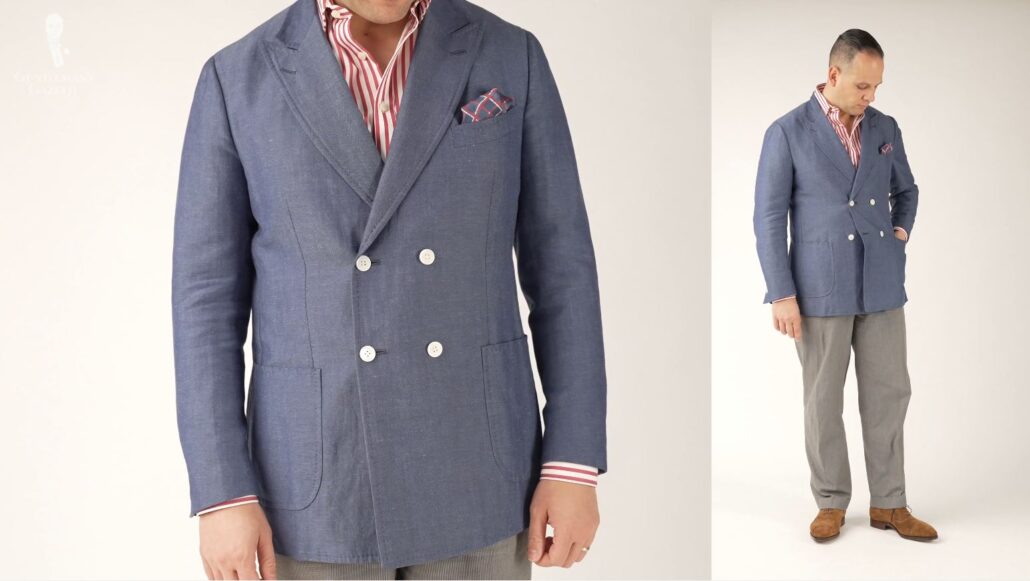
My slacks are micropatterned; kind of navy and off-white from Polo Ralph Lauren.
My shoes are a pair of quarter brook Oxfords in a nice brown suede from Spanish brand Yanko. And my socks are blue and red socks from Fort Belvedere that provide enough contrast between the pants and the shoes, but also pick up the color scheme of red and blue from the top half of the outfit.
The other jacket I have is a really nice double-breasted sport coat in a brown worsted with an off-white window pane. It has these beautiful matching mother-of-pearl buttons and I like it quite a bit.

Otherwise, I have three single-bracelet jackets. One is a really nice cashmere cotton. It’s a little thicker with an open weave and quite airy. It’s the oldest jacket I have from them. It has three patch pockets – nice, lighter colored, horn buttons, and I think it’s very beautiful. Then, I have the Aquaspider 160s blazer, which is just a plain kind of twill weave – navy, classic fabric. Last but not least, I have this nice, fine herringbone jacket in kind of a darker brown and very light brown. It is not too over-scaled in size. It has peak lapels interestingly and it’s made of wool, linen, and silk, which is a very nice hand but it’s intentionally left very casual.

Wow! Enjoy your stuff, but you’ve put me over the edge today!!!
First, do y’all ever proofread your posts? It’s regularly frustrating, but this one is particularly egregious in its collection of errors – grammar, spelling and incorrect info. Most could be corrected with an extra pair of eyes. You spend a good bit of time, rightly, promoting the idea that details are important. Physician, heal thyself!
One that must not go unmentioned is that “staple length” has nothing to do with wool. It is a technical term regarding quality of cotton fiber.
Get back on your game guys!
Raphael,
I did invest and enjoyed many seasons,,, Gregory Hines designed and I was his “Muse.’
2 suits pantd w I jacket 2 slacks. 1 suite Bringing uP Baby tweed look english country. 3/2 label rolled into button placement and open front. Cary Grant. Single pleat trou, 2 ” cuff. Grandads odd vest.
Slighted robed shoulders still good comments Fall, Winter, new Spring Minnesota. Suit 2 ” dusty rust. bone ground pewter highlites POW. !00% Cashmere lined of course 3/2 roll. I shrunk out of this got a good second home. Jacket destroyed in rain storm. Costs appropriate 2001. Lives happily on.
Best/Jim